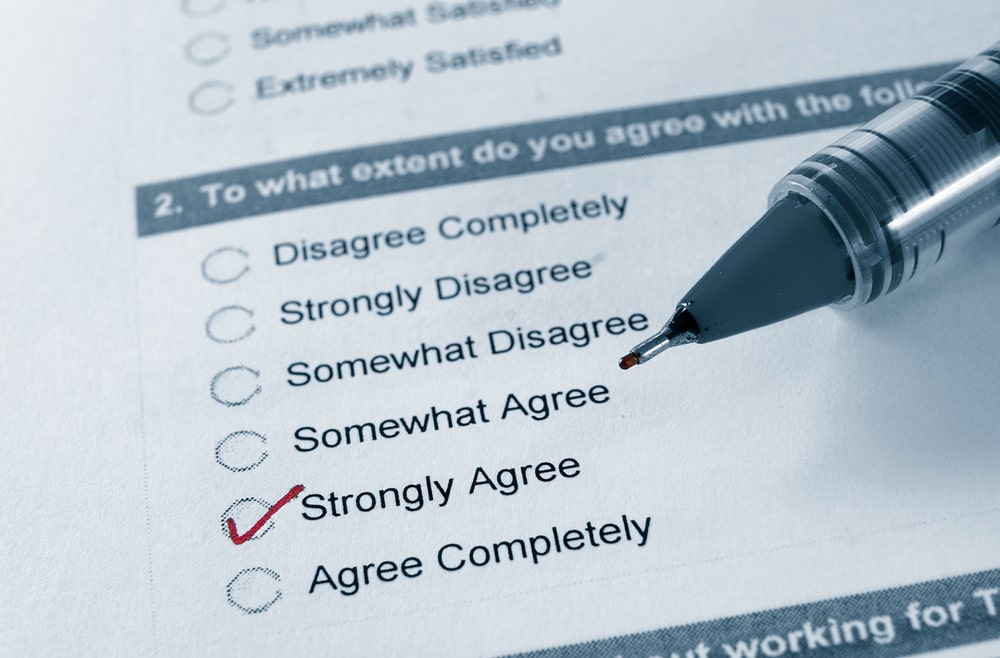The success of your marketing depends on in-depth knowledge of your customers and other audiences. Unfortunately, many companies—even large ones with sizable marketing budgets—seem to be allergic to conducting market and customer surveys. The cost and time involved scare them off.
That’s unfortunate, because this research, done well, is the most precise way to identify your target buyers, their purchasing habits, and their sources of influence, as well as to measure your success in building brand awareness and trust.
Effective research doesn’t have to break the bank. You could have questionnaires on your website, asking how visitors discovered you, or if they have heard of you before. You could ask your current customers when and how they learned about your brand. You could ask prospects who ultimately chose a competitor the reasons for their decision.
Knowing what style of questions to use on a buyer survey, how to phrase them, how to arrange them, and how to analyze the results will improve the quality of the information you receive—and the value of your investment.
Here are some tips for getting started.
The Styles of Questions on Your Survey

Open-Ended Questions
Open-ended questions allow customers to respond with their ideas in their own words. These questions can reveal both strengths and areas for improvement that never occurred to you. You can use the responses to maximize newly revealed strengths and address newly revealed weaknesses.
On the flip side, open-ended questions create difficulties in analyzing responses. Further, because writing responses requires time, customers may ignore these questions.
Closed-Ended Questions
Closed-ended questions provide customers with a structured selection of answers. Surveys with these types of questions are quick and easy for customers. The responses are also easy to analyze statistically. You are likely to get more responses to surveys with closed-ended responses, but they lack the insights that might come from a survey with open-ended questions. Closed-ended questions include:
- Rating scales
- Multiple choice questions
- Ranking scales
Rating Scales

Rating scales ask customers to respond by choosing a number, usually between 1 and 5 or 1 and 10. You can use these to learn how much a customer likes or dislikes something or how much they agree or disagree with a particular statement. The scales can include questions or statements about your business, your products, and services, or different departments of your business.
Multiple Choice Questions
Multiple choice questions provide answers you write, such as strongly disagree, disagree, neither agree nor disagree, agree, and strongly agree. The customer needs only to check a box next to the answer closest to their feelings. You can add an option such as none of the above or other to your prewritten answers and leave a space on a printed survey or a text box on an online survey to allow customers to respond in their own words.
You can create a grid of multiple choice answers to ask what publications your customers read, what news providers they use, what television and cable channels they listen to, what podcasts they follow, and so on. Multiple choice questions might also include questions that require only yes or no answers.
Demographic questions are often posed as multiple-choice queries. Questions that might be relevant to your business include:
- age ranges
- income ranges
- educational level
- relationship status
- gender identity
Businesses attracting global customers could include geographic location as well.
Ranking Scales
Ranking scales can be used to ask buyers to rank your products or services in order of how often they use them. You can also ask customers to rank your brand reputation, product, or customer service against those of your competitors.
Additionally, you might ask how customers compare their use of various social media platforms, or to rank their consumption of specific podcasts and blogs.
Phrasing Your Questions

When writing your questions, keep in mind two rules:
- Each question should raise only a single subject or issue.
- Each question should be phrased using neutral language.
After you write your questions, read them carefully to ensure that the subject of the question is clear and that the customer will not feel led or encouraged to answer in a particular way. Have someone else read your questions to ensure that they also understand the subject of each question and that they don't feel led to answer in a particular way.
For example, if you ask how much time a customer spends watching YoutTube videos, don't include watching for entertainment and watching to gather product information in the same question. Ask one question about how much time they spend watching videos for entertainment and ask a separate question about how much time they spend watching videos to gather information about products.
Formatting Your Survey

To gain the most in-depth knowledge, mix open-ended questions with closed-ended questions. As with your questions, keep your survey focused on a single goal, such as increasing sales conversions, finding out which breadcrumb trails to use, or what new product or service your customers would find most useful.
Include an introduction to your survey that explains why you're asking customers to take their time to respond. Mention how your customers benefit from taking the time to answer. If your customers feel that the survey and the questions matter, they're more likely to respond.
Start your survey with one to three open-ended questions. Specifically, target these questions to the purpose of your survey.
Most of the survey should consist of closed-ended questions. Include rating scales, multiple choice, and ranking questions. You can rephrase the same question and ask it again using each type of question to gain more insight.
Close your survey with one to three more open-ended questions. This final group of open-ended questions will capture any additional thoughts or insights that may have occurred to your customer while responding to the closed-ended questions in your survey. These closing questions also should be targeted to the purpose of your survey. Don't close your survey with a generic question that simply asks for any additional thoughts, comments, or information. Specific questions are more likely to get a response.
Printed or Online Survey
You can print out a survey to hand to customers who interact with you or your employees, or you can conduct an online survey. If you have customers who only make online purchases, then, of course, you'll want to conduct your survey online. If you have customers who come to your business or interact with employees who come to their home or place of business, then you might want to print out a survey—or alternatively, provide a tablet for filling out an online survey.
Because you're asking customers to take some of their time to fill out your survey, you'll want to keep either a print or online survey short. A print survey could be longer than an online survey, but either way customers tire of answering never-ending surveys. Other suggestions from SurveyMonkey include:
- Testing your survey on different mobile devices, such as a smartphone, a tablet, and Windows, Android, and Apple devices
- Keeping the survey short by focusing only on your most important questions
- Phrasing most questions as multiple choice questions
Analyzing the Results of Your Survey
If you've done a paper survey, you'll likely need to analyze the results by hand. That's another reason to keep a survey short. Tabulating the results of closed-ended questions is simple. Write down each question and use tally marks to record the number of responses you got to each answer you provided.
For example, tally all of the answers under the number 3 on a rating scale, the number of responses marked agree on multiple choice questions, or the number of times the subject of your question was ranked at a particular level.
Comparing Demographic Data to Survey Results

If you've collected demographic data along with the answers to other questions, note the answers to the demographic questions and compare those to the answers to the other question across the various demographic categories.
Finding that customers from the same demographic category have provided similar answers to your questions helps you better target your marketing. Knowing the demographics of your market segments helps you to discover the best way to reach each segment. You may also decide to focus on the segment that provides you with the bulk of your business rather than continuing to target multiple segments.
Analyzing Open-Ended Survey Questions
As you read the answers to each open-ended survey question, you're likely to find that the answers begin to suggest categories. Jot down the categories, and tally the answers that fall into each category. If you find particularly insightful comments, note those as suggestions for actions to take.
As with the closed-ended questions, you can cross-reference the answers to the open-ended questions to any demographic information you obtained. Look for similarities among the answers of those from the same demographic category and for differences among the answers of those from different demographic segments.
Closing Thoughts
A well-conceived customer survey with carefully written questions can provide invaluable insights into your customers, your business, your products and services, your website design and content, and your marketing.
Be sure to:
- Begin your survey with an introduction that creates an interest among your customers that encourages them to take the time to complete the survey
- Use open-ended questions at the beginning and end with closed-ended questions in the middle.
- Include relevant demographic questions.
- Keep your survey short by focusing on one specific business goal, and focus each question on a single subject that provides information that will help you achieve your goal.
- Phrase each question using neutral language to avoid guiding your customer's answers.
- For open-ended questions, read the answers, look for the categories they suggest, and tally the answers using those categories. Note any suggestions for actions that you'll want to take.
- If you have included demographic results, cross reference the answers to your survey questions to the different market segments indicated by your demographics.

 9 min read
9 min read





 4 min read
4 min read

